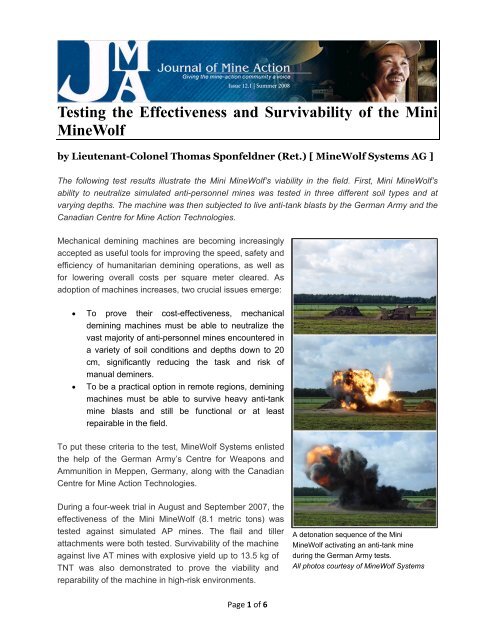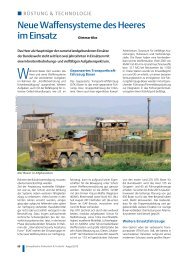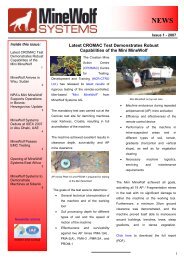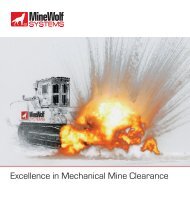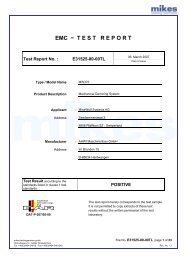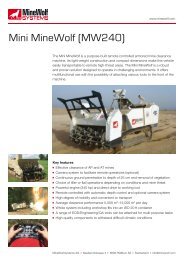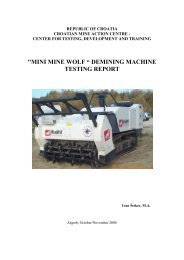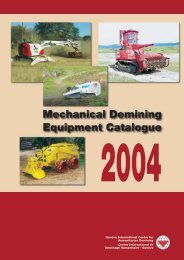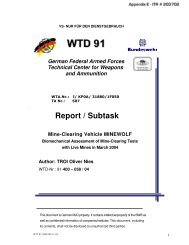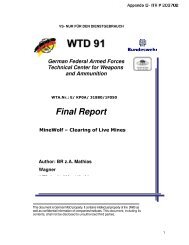Testing the Effectiveness and Survivability of the Mini MineWolf
Testing the Effectiveness and Survivability of the Mini MineWolf
Testing the Effectiveness and Survivability of the Mini MineWolf
You also want an ePaper? Increase the reach of your titles
YUMPU automatically turns print PDFs into web optimized ePapers that Google loves.
<strong>Testing</strong> <strong>the</strong> <strong>Effectiveness</strong> <strong>and</strong> <strong>Survivability</strong> <strong>of</strong> <strong>the</strong> <strong>Mini</strong><br />
<strong>MineWolf</strong><br />
by Lieutenant-Colonel Thomas Sponfeldner (Ret.) [ <strong>MineWolf</strong> Systems AG ]<br />
The following test results illustrate <strong>the</strong> <strong>Mini</strong> <strong>MineWolf</strong>’s viability in <strong>the</strong> field. First, <strong>Mini</strong> <strong>MineWolf</strong>’s<br />
ability to neutralize simulated anti-personnel mines was tested in three different soil types <strong>and</strong> at<br />
varying depths. The machine was <strong>the</strong>n subjected to live anti-tank blasts by <strong>the</strong> German Army <strong>and</strong> <strong>the</strong><br />
Canadian Centre for Mine Action Technologies.<br />
Mechanical demining machines are becoming increasingly<br />
accepted as useful tools for improving <strong>the</strong> speed, safety <strong>and</strong><br />
efficiency <strong>of</strong> humanitarian demining operations, as well as<br />
for lowering overall costs per square meter cleared. As<br />
adoption <strong>of</strong> machines increases, two crucial issues emerge:<br />
• To prove <strong>the</strong>ir cost-effectiveness, mechanical<br />
•<br />
demining machines must be able to neutralize <strong>the</strong><br />
vast majority <strong>of</strong> anti-personnel mines encountered in<br />
a variety <strong>of</strong> soil conditions <strong>and</strong> depths down to 20<br />
cm, significantly reducing <strong>the</strong> task <strong>and</strong> risk <strong>of</strong><br />
manual deminers.<br />
To be a practical option in remote regions, demining<br />
machines must be able to survive heavy anti-tank<br />
mine blasts <strong>and</strong> still be functional or at least<br />
repairable in <strong>the</strong> field.<br />
To put <strong>the</strong>se criteria to <strong>the</strong> test, <strong>MineWolf</strong> Systems enlisted<br />
<strong>the</strong> help <strong>of</strong> <strong>the</strong> German Army’s Centre for Weapons <strong>and</strong><br />
Ammunition in Meppen, Germany, along with <strong>the</strong> Canadian<br />
Centre for Mine Action Technologies.<br />
During a four-week trial in August <strong>and</strong> September 2007, <strong>the</strong><br />
effectiveness <strong>of</strong> <strong>the</strong> <strong>Mini</strong> <strong>MineWolf</strong> (8.1 metric tons) was<br />
tested against simulated AP mines. The flail <strong>and</strong> tiller<br />
attachments were both tested. <strong>Survivability</strong> <strong>of</strong> <strong>the</strong> machine<br />
against live AT mines with explosive yield up to 13.5 kg <strong>of</strong><br />
TNT was also demonstrated to prove <strong>the</strong> viability <strong>and</strong><br />
reparability <strong>of</strong> <strong>the</strong> machine in high-risk environments.<br />
Page 1 <strong>of</strong> 6<br />
A detonation sequence <strong>of</strong> <strong>the</strong> <strong>Mini</strong><br />
<strong>MineWolf</strong> activating an anti-tank mine<br />
during <strong>the</strong> German Army tests.<br />
All photos courtesy <strong>of</strong> <strong>MineWolf</strong> Systems
To simulate AP mines, wirelessly-operated<br />
reproduction mines were used. Designed by CCMAT,<br />
WORM mines simulate <strong>the</strong> physical properties <strong>of</strong><br />
typical AP mines, <strong>and</strong> are equipped with sensors <strong>and</strong><br />
radio frequency transmitters to detect <strong>and</strong> report<br />
damage inflicted by <strong>the</strong> machine via a wireless link to a<br />
remote, personal computer. 1<br />
The trial, held at <strong>the</strong> Germany Army weapons testing<br />
site in Meppen, followed formal guidelines set down by<br />
<strong>the</strong> European Committee for St<strong>and</strong>ardization for <strong>the</strong><br />
testing <strong>and</strong> evaluation <strong>of</strong> demining machines. 2<br />
A disassembled WORM mine<br />
The CEN Workshop Agreement 15044 was initiated in June 2003 <strong>and</strong> is <strong>the</strong> result <strong>of</strong> a Swedish<br />
Explosive Ordnance Disposal <strong>and</strong> Demining Center initiative, with participation from <strong>the</strong> Croatian<br />
Mine Action Center <strong>and</strong> <strong>the</strong> Geneva International Centre for Humanitarian Demining, which<br />
culminated in <strong>the</strong> European Commission funding a workshop to develop an agreement for <strong>the</strong> testing<br />
<strong>of</strong> mechanical demining machines.<br />
A main reason for establishing <strong>the</strong> testing guidelines for mechanical demining machines was that “a<br />
lot <strong>of</strong> [<strong>the</strong>] test <strong>and</strong> evaluation work … performed in <strong>the</strong> demining world today, in many instances …<br />
is not what most <strong>of</strong> <strong>the</strong> demining community or developers need. To improve this situation it was<br />
necessary to provide an agreement whereby each piece <strong>of</strong> equipment would be tested under <strong>the</strong><br />
same conditions, using criteria that can withst<strong>and</strong> technical scrutiny.” 2<br />
The German Army clearance test <strong>of</strong> <strong>the</strong> <strong>Mini</strong> <strong>MineWolf</strong> followed <strong>the</strong> workshop guidelines: to test,<br />
under controlled <strong>and</strong> reproducible conditions, <strong>the</strong> capability <strong>of</strong> <strong>the</strong> machine to clear (i.e., detonate,<br />
destroy or remove) mines at different depths in different types <strong>of</strong> soil. The test was performed in<br />
three different ground configurations at three depths from flush with <strong>the</strong> surface to <strong>the</strong> maximum<br />
penetration depth <strong>of</strong> 20 cm. All test conditions are dictated by CEN agreement specifications.<br />
Test Conditions<br />
Three lanes were prepared, each with a homogenous<br />
soil type (gravel, s<strong>and</strong> <strong>and</strong> topsoil).<br />
• The soil in <strong>the</strong> lanes was separated from <strong>the</strong><br />
surrounding soil.<br />
• The lanes had such width <strong>and</strong> depth that <strong>the</strong><br />
machine <strong>and</strong> its tool did not interfere with <strong>the</strong><br />
soil outside <strong>the</strong> lane.<br />
Page 2 <strong>of</strong> 6<br />
Measurements <strong>of</strong> mines at different soil depths.<br />
Figure courtesy <strong>of</strong> <strong>the</strong> author/MAIC
The three soil types specified by <strong>the</strong> CEN Workshop agreement <strong>and</strong> implemented by <strong>the</strong> German<br />
Army during <strong>the</strong> tests were:<br />
• Gravel with particle size from 0.075 mm to 45 mm, <strong>of</strong> which 10 percent is less than 0.4 mm,<br />
<strong>and</strong> <strong>the</strong>n a size distribution up to 45 mm normally specified as 0–32 mm<br />
• S<strong>and</strong> (e.g., with particle size from 0.075 mm to 20 mm, with 85 percent less than 0.6 mm)<br />
• Topsoil which may have different contents <strong>of</strong> organic material. Locally available topsoil is<br />
accepted but <strong>the</strong> particle size must be from 0.001 up to 31 mm<br />
Before every run <strong>the</strong> soil was “cultivated, or o<strong>the</strong>rwise loosened up, <strong>and</strong> <strong>the</strong>n compacted to its<br />
original state again.” The level <strong>of</strong> compactness was measured <strong>and</strong> recorded using 10 points<br />
r<strong>and</strong>omly distributed along <strong>the</strong> lane. The measurement was done with a densiometer <strong>and</strong> at <strong>the</strong><br />
expected clearance depth. The soil density conditions according to <strong>the</strong> CEN agreement were as<br />
follows:<br />
• Gravel: 94 percent average <strong>of</strong> <strong>the</strong> measurement ±2 percent (e.g., 94 percent <strong>of</strong> <strong>the</strong> maximum<br />
<strong>the</strong>oretical dry density)<br />
• S<strong>and</strong>: 90 percent average <strong>of</strong> <strong>the</strong> measurement ±2 percent<br />
• Topsoil: 85 percent average <strong>of</strong> <strong>the</strong> measurement ±2 percent<br />
Target Deployment<br />
The “mines,” in this case <strong>the</strong> simulated AP, or<br />
WORM mines, were laid at three depths:<br />
flush with surface, at 10 cm <strong>and</strong> at a<br />
maximum depth <strong>of</strong> 20 cm. The target mines<br />
were laid without pattern along <strong>the</strong> lane within<br />
<strong>the</strong> following constraints: mines should not be<br />
within 0.5 m <strong>of</strong> each o<strong>the</strong>r <strong>and</strong> should be<br />
distributed to cover 50 percent <strong>of</strong> <strong>the</strong> width <strong>of</strong><br />
<strong>the</strong> working tool. The targets were placed<br />
with minimum disturbance to <strong>the</strong> surrounding<br />
ground. A total <strong>of</strong> 900 WORM mines were<br />
laid, 50 for each unique test condition.<br />
Results <strong>of</strong> WORM<br />
Trials<br />
<strong>Mini</strong> <strong>MineWolf</strong> during German Army Tests, (gravel, 20 cm)<br />
The purpose <strong>of</strong> <strong>the</strong> trial was to German Army tests with flail attachment—WORM mines neutralized.<br />
determine <strong>the</strong> capability <strong>of</strong> <strong>the</strong><br />
<strong>Mini</strong> <strong>MineWolf</strong> to neutralize AP<br />
mines at three different depths in<br />
three different types <strong>of</strong> soil:<br />
gravel, s<strong>and</strong> <strong>and</strong> topsoil, based German Army tests with tiller attachment—WORM mines neutralized.<br />
Page 3 <strong>of</strong> 6
on a statistically meaningful sample—in this case 900 WORM mines in 18 different test conditions.<br />
The results <strong>of</strong> <strong>the</strong> trial showed that <strong>the</strong> <strong>Mini</strong> <strong>MineWolf</strong> was successful against <strong>the</strong> simulated AP<br />
mines with both flail <strong>and</strong> tiller attachments. The actual results with both attachments are as follows:<br />
According to <strong>the</strong> <strong>of</strong>ficial results published by <strong>the</strong> German Army, “The total <strong>Mini</strong> <strong>MineWolf</strong> clearance<br />
rate resulting from <strong>the</strong> performance tests was approximately 99 percent. At a clearance width <strong>of</strong><br />
1,860 mm, <strong>the</strong> <strong>Mini</strong> <strong>MineWolf</strong> worked at an operating speed between 781 sq m/hr <strong>and</strong> 1,595 sq<br />
m/hr.” 3<br />
<strong>Survivability</strong> <strong>Testing</strong><br />
The ability <strong>of</strong> <strong>the</strong> demining<br />
machine to effectively<br />
neutralize AP mines is<br />
only useful if <strong>the</strong> machine<br />
can also withst<strong>and</strong> heavy<br />
anti-tank mine blasts with<br />
minimum damage or at<br />
least damage easily<br />
repairable in <strong>the</strong> field. In<br />
many minefield<br />
environments, both AP<br />
<strong>and</strong> AT mine threats are<br />
simultaneously present.<br />
The final test <strong>of</strong> <strong>the</strong> <strong>Mini</strong><br />
<strong>MineWolf</strong> was <strong>the</strong>refore to<br />
demonstrate <strong>the</strong><br />
survivability <strong>of</strong> <strong>the</strong><br />
machine against heavy AT<br />
mine blasts with damage<br />
that could be repaired<br />
onsite. Here again, <strong>the</strong><br />
test adhered to <strong>the</strong> CEN<br />
Workshop agreement<br />
describing “<strong>Survivability</strong><br />
Test <strong>of</strong> Demining<br />
Machines,” which states<br />
that “survivability is based<br />
on <strong>the</strong> materials used,<br />
design features <strong>and</strong> threat<br />
for which <strong>the</strong> machine has<br />
been designed. The test<br />
focuses on two distinct<br />
<strong>Mini</strong> <strong>MineWolf</strong> Anti-Tank Mine Trials: Tests Conducted.<br />
AT Mine <strong>Survivability</strong> Results: <strong>Mini</strong> <strong>MineWolf</strong> Tiller.<br />
AT Mine <strong>Survivability</strong> Results: <strong>Mini</strong> <strong>MineWolf</strong> Flail.<br />
Page 4 <strong>of</strong> 6
areas: Machine survivability—<strong>the</strong> blast effect from mines on <strong>the</strong> machine—<strong>and</strong> operator<br />
survivability—<strong>the</strong> level <strong>of</strong> protection afforded to operators subjected to <strong>the</strong> effects <strong>of</strong> blast.” 2<br />
In <strong>the</strong> case <strong>of</strong> <strong>the</strong> <strong>Mini</strong> <strong>MineWolf</strong>, which is remotely-controlled, only <strong>the</strong> first criterion is relevant.<br />
During tests <strong>of</strong> <strong>the</strong> <strong>Mini</strong> <strong>MineWolf</strong> against live AT mines during 10–26 September 2007, <strong>the</strong> blast<br />
effects on <strong>the</strong> tool were evaluated under controlled conditions using live anti-tank mines TM-57, TM-<br />
62M, DM-11, DM-21, TMA-4, TM-62 P3, PT-MI-BA III. 4 Three tests including DM 21/TMA 4 <strong>and</strong> PT-<br />
Mi-Ba-III/TM 62 P3 mine stacks with an explosive yield <strong>of</strong> up to 13.5 kg were conducted. Both tiller<br />
<strong>and</strong> flail attachments were tested.<br />
At <strong>the</strong> conclusion <strong>of</strong> <strong>the</strong> AT mine tests, survivability <strong>of</strong> <strong>the</strong> <strong>Mini</strong> <strong>MineWolf</strong> was established—after 14<br />
detonations, no operational damage to <strong>the</strong> prime mover was inflicted.<br />
Reparability <strong>of</strong> <strong>the</strong> working tools in <strong>the</strong> field was also established; “<strong>the</strong> repairs, mainly welding work,<br />
could be performed on site <strong>the</strong> same day, “according to <strong>the</strong> <strong>of</strong>ficial German Army report. 3<br />
At <strong>the</strong> conclusion <strong>of</strong> <strong>the</strong> trials, Colonel Radlmeier, Chief <strong>of</strong> <strong>the</strong> Development Division <strong>of</strong> <strong>the</strong> German<br />
Army Engineering School, reported that “<strong>the</strong> ability to provide safe clearance capabilities in<br />
areas contaminated with explosive remnants <strong>of</strong> war is becoming increasingly significant to<br />
<strong>the</strong> future tasks <strong>of</strong> <strong>the</strong> German Army's Corp <strong>of</strong> Engineers. … We need a reliable, quickly<br />
deployable mechanical mine-clearance tool. The <strong>Mini</strong> <strong>MineWolf</strong> is, based on real-world tests<br />
<strong>and</strong> its convincing results, a very interesting option to fill this gap."<br />
A full report entitled “<strong>Mini</strong> <strong>MineWolf</strong> Test <strong>and</strong> Evaluation, August–September 2007; German Army<br />
(Bundeswehr) Technical Center for Weapons <strong>and</strong> Ammunition (WTD 91)” has been published by <strong>the</strong><br />
German Army in both English <strong>and</strong> German <strong>and</strong> is available from <strong>the</strong> International Test <strong>and</strong><br />
Evaluation Program for Humanitarian Demining. 3<br />
Page 5 <strong>of</strong> 6
Biography<br />
Thomas Sponfeldner is Project Manager at <strong>MineWolf</strong> Systems. He holds a<br />
degree in engineering <strong>and</strong> has served 30 years in <strong>the</strong> German Army (Lieutenant-<br />
Colonel, ret.), including service as Company Comm<strong>and</strong>er <strong>of</strong> an independent<br />
armored engineer company <strong>and</strong> as Instructor <strong>of</strong> <strong>the</strong> Engineer Officer Cadet<br />
Course. He has spent <strong>the</strong> previous nine years at <strong>the</strong> Development Division <strong>of</strong> <strong>the</strong><br />
German Army Engineering School, being responsible for demining equipment <strong>and</strong><br />
training, as well as testing <strong>of</strong> mechanical demining systems. In 2002 he was<br />
stationed in Afghanistan as Officer in Charge <strong>of</strong> <strong>the</strong> first mechanical demining operations <strong>of</strong> <strong>the</strong><br />
German Army Corps <strong>of</strong> Engineers.<br />
Endnotes<br />
1. Due to <strong>the</strong> extreme danger <strong>of</strong> working with a large number <strong>of</strong> live AP mines, as well as <strong>the</strong>ir<br />
scarcity due to <strong>the</strong> effectiveness <strong>of</strong> <strong>the</strong> Ottawa Convention ban on AP l<strong>and</strong>mine stockpiling <strong>and</strong><br />
production, simulated AP mines were used for <strong>the</strong> test.<br />
2. "CEN Workshop Agreement, Test <strong>and</strong> Evaluation <strong>of</strong> Demining Machines," CWA 15044, July<br />
2004. http://www.itep.ws/pdf/CWA_demining_machines.pdf. Accessed 29 July 2008.<br />
3. “<strong>Mini</strong> <strong>MineWolf</strong> Test <strong>and</strong> Evaluation, August–September 2007; German Army (Bundeswehr)<br />
Technical Center for Weapons <strong>and</strong> Ammunition (WTD 91),” Summary. http://www.itep.ws/pdf/<br />
FinalReport<strong>Mini</strong><strong>MineWolf</strong>2007.pdf. Accessed 18 June 2008.<br />
4. For more information each <strong>of</strong> <strong>the</strong>se munitions, see <strong>the</strong> Mine Action Information Center’s<br />
“Munitions Reference.” Available at http://maic.jmu.edu/journal/supplemental/munitions.htm.<br />
Last updated 27 July 2007. Accessed 5 August 2008.<br />
Contact Information<br />
Thomas Sponfeldner<br />
Project Manager<br />
<strong>MineWolf</strong> Systems AG<br />
Seedammstrasse 3<br />
8808 Pfäffikon SZ /Switzerl<strong>and</strong><br />
Phone: +41 (0) 555 111 500<br />
Fax: +41 (0) 555 111 599<br />
E-mail: t.sponfeldner@minewolf.com<br />
Web site: http://www.minewolf.com<br />
(c) 2008 Journal <strong>of</strong> Mine Action, Mine Action Information Center. All rights reserved.<br />
If cited properly, short sections (a sentence or two) can be used without permission. Written Journal <strong>of</strong> Mine Action approval<br />
is required, however, before longer sections <strong>of</strong> JMA published content may be used by ano<strong>the</strong>r source or publication.<br />
Page 6 <strong>of</strong> 6


